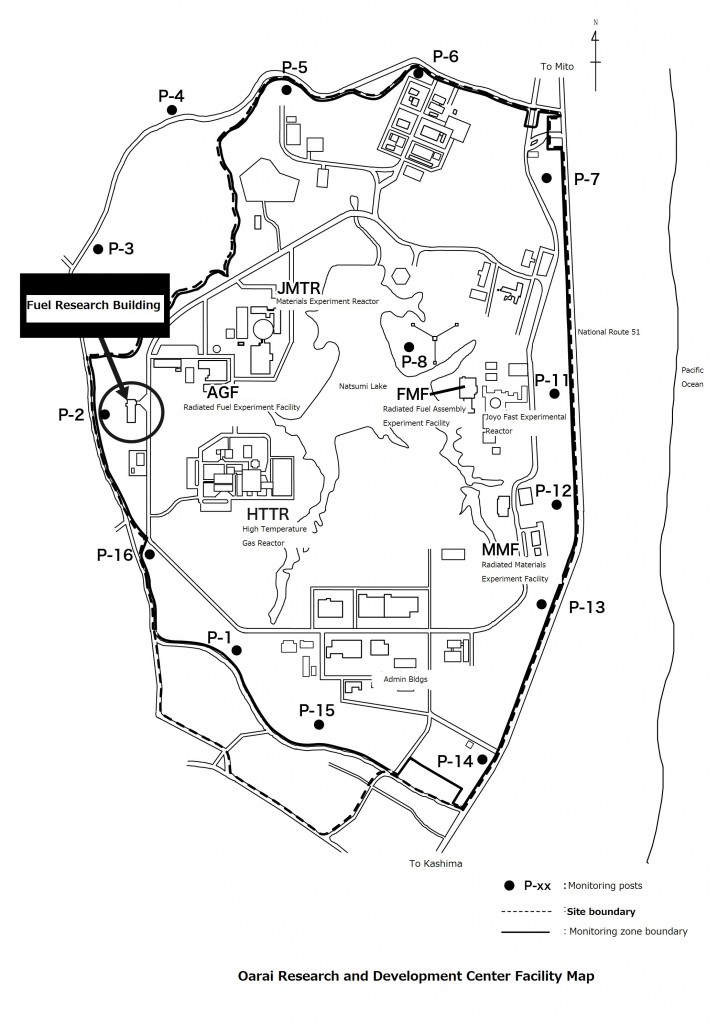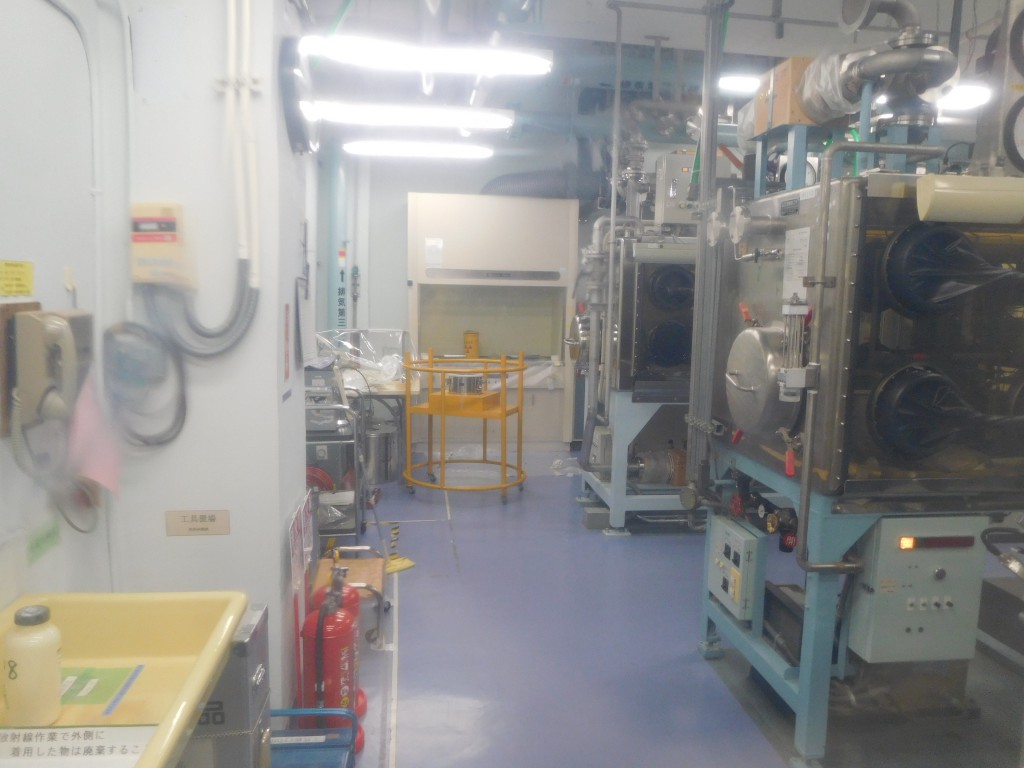Disturbing Plutonium Exposure Accident
 Plutonium Dust Release at Japan Atomic Energy Agency’s Oarai Research and Development Center Fuel Research Building
Plutonium Dust Release at Japan Atomic Energy Agency’s Oarai Research and Development Center Fuel Research Building
While there are many unknowns regarding the accident and its cause, the exposure of the task personnel and other matters, we report here on what has become clear thus far and the problems that the accident poses. The Nuclear Regulation Authority (NRA) is scheduled to release the agency’s “report” about a month after the accident.
Table 1 shows a timeline of the events based on releases by the JAEA, NRA and news media.
Several black lumps fell onto the floor in Room 108, from which a maximum of 55 Bq/cm2 were detected. The facility management supervisor instructed that a greenhouse (a temporary enclosure to implement detection and decontamination when retreating from the contaminated area) be set up at 11:54, and it is reported that this was completed at 14:29. More than three hours passed between the time of the accident and the time when the five task personnel exited the greenhouse. Concerning the delay in setting up the greenhouse, JAEA explained to NRA that “(The delay occurred because) the main work personnel in the Fuel Research Building were carrying out this work and other staff were engaged in stabilizing procedures for nuclear fuel materials (and could not leave their positions).”
As a result of a nasal smear (to detect contamination in the nostrils) taken inside the greenhouse, contamination of a maximum of 24 Bq (α radiation) was detected in the nostrils of three of the five personnel.
The five task personnel finally exited the controlled area at 18:55. Since α radiation had been detected in their nostrils and there was a strong possibility that the five people had inhaled plutonium, they were transported to the Nuclear Fuel Cycle Engineering Labs in Tokai Village, where measurement of plutonium inside their lungs was carried out using a lung monitor. Lung monitors detect the weak X-rays emitted by plutonium-239 and the gamma radiation emitted from americium-241 inside the lungs from outside the body. However, not only is this detection extremely difficult, it has poor sensitivity. The JAEA measurement results are shown in Table 2. If plutonium were to be detected, it would have to be around 10,000 Bq or more. The task personnel were men in their 20s to 50s, two of whom were JAEA personnel, one was a dispatched staffer, and two were subcontracted company personnel. The person in whom 24 Bq of contamination was detected by nasal smear was a JAEA staff member and the main person carrying out the task.
JAEA gave the result of the effective dose (committed dose over 50 years) measurement on the assumption that the 22,000 Bq of Pu-239 detected 0.4 days (9.6 hours) after the accident was the total amount of plutonium remaining (deposited) in the lungs. At that time, the parameters are assumed to be as follows.
Proportion remaining in the lungs after 0.4 days: 6.06×10-2
(Residual dose/ingested dose)
Effective dose coefficient: 3.2×10-5 [Sv/Bq]
(Value for compounds other than insoluble oxidized Pu-239)
From this, the ingested dose is
22,000 [Bq] / 6.06×10-2 = 3.6 × 105 [Bq]
And the committed dose is estimated to be
3.6 × 105 [Bq] × 3.2×10-5 [Sv/Bq] = 12 [Sv]
The maximum exposed dose due to the plutonium inhaled in the accident is thus said to be 12 Sv.
The materials in the storage canister were said to be, according to a JAEA explanation to NRA on June 8 and a “Follow-up Report 4” on June 15, “Pu oxide, U oxide and others used in experiments, etc. for developing fast reactor nuclear fuel,” and the details of the contents “confirmed to be 26.9% Pu, 73.1% U, after converting the total nuclear fuel materials to metal weight.” However, while stating that the remaining composition and constituents, other than the above, were being examined, JAEA said, “In the current situation, we would like to refrain from public disclosure from the viewpoint of nuclear non-proliferation.”
The Fuel Research Building (completed in 1974, decided in 2013 to discontinue use) is a facility for the manufacture of new nuclear fuels and research into the properties of fuels such as mixed uranium-plutonium carbide fuel and nitride fuel for use in fast reactors. The material causing the generation of gas by radiation decomposition that has been reported by the media is thought to be a material containing plutonium compounds solidified possibly using an epoxy-type adhesive bond for storage.
The five persons thought to have suffered internal exposure to plutonium were admitted to the hospital of the National Institute of Radiological Sciences (NIRS) on June 7 and measurement using a lung monitor was carried out after decontamination. According to the lung monitor measurement at NIRS, plutonium was detected from none of the task personnel (though americium was detected). At the same time, tests to detect plutonium in excreta were also carried out.
Since plutonium was not detected by the lung monitor and thus there was apparently no bodily contamination, the five task personnel were discharged from the NIRS hospital on June 13. NIRS met with the five persons on June 16 to take blood samples, and when they were told that plutonium had been detected in the urine of all five persons, it was recommended that they be rehospitalized. The amounts of plutonium and other substances detected in the urine have not been disclosed. The task personnel in whom plutonium was undetected by the lung monitor had, in fact, inhaled plutonium. All five were rehospitalized by June 18 and an intravenous drip of a chelating agent and other treatments were given.
JAEA has explained that “bursting of the plastic bags during the task was not foreseen” and therefore a fume hood rather than a sealed glovebox was used for the work. However, it is common sense for a glovebox to be used for a task where a special substance such as plutonium is to be handled. It is extremely hard to understand why the facility had adopted this procedure for the work.
An important reason for the implementation of this task is found in the problems uncovered for the first time by a safety inspection last year.
In the safety inspection carried out with respect to JAEA’s Nuclear Science Research Institute (Tokai Village) in the third quarter of fiscal year 2016, it was discovered that, in violation of classifications provided in the safety regulations, nuclear fuel materials had been cited as being “in use” and stored in cells and gloveboxes for long periods of time. As a result, NRA instigated checks through safety inspections on the possibility that there might be similar violations at other nuclear-related facilities, including other JAEA facilities.
According to NRA materials of February 2017, a total of ten facilities engaging in reprocessing, processing and use of nuclear fuels had been carrying out inappropriate long-term storage of nuclear fuel materials: The JAEA Nuclear Fuel Cycle Engineering Labs, Nuclear Science Research Institute, Oarai Research and Development Center (northern section), Oarai Research and Development Center (southern section), and Ningyo-toge Environmental Engineering Center, as well as Japan Nuclear Fuel Ltd. (reprocessing facility), Nuclear Development Co., Ltd., the Rokkasho Nuclear Material Control Center, and others.
With reference to these facilities, NRA points out that “Management in accordance with the classifications (use, storage, disposal) provided for in the safety regulations was not strictly carried out,” and at the same time, essentially recognizing inappropriate management. NRA stated, “The reality is that materials were being stored in what are known in the safety regulations as use facilities – cells, gloveboxes, fume hoods, etc. – but taking into account the amount and types of nuclear fuel materials, the storage situations were not highly dangerous. Safeguard management was also appropriately performed,” “The facility operators… have drawn up a work plan (plan for corrective measures) to implement use, storage and disposal of nuclear fuel materials according to the safety regulations and are gradually implementing the work based on the plans for corrective measures.”
Further, “Taking into account the facts that nuclear fuel materials underwent long-term storage in what are use facilities under the safety regulations, and the fact that present and past regulatory authorities had not communicated to the facility operators their view that a breach of safety regulations had occurred, and that the facility operators are taking corrective measures within a rational time period, NRA has responded flexibly by requesting that improvement be made in accordance with the matters pointed out.” The background to this is that nuclear fuel facilities, use facilities, etc., for which the establishment of severe accident response facilities are not mandated, are considered “low-risk.” The basis for this is the NRA’s “safety myth; the judgment that it is fine for these facilities to be treated in a different manner from nuclear power plants and other facilities in terms of safety inspections.
This inappropriate long-term storage problem clearly shows, if one looks back at the historical series of organizations – the Nuclear Safety Commission, the Nuclear and Industrial Safety Agency and the NRA, that for 30 years or more none of these organizations made any public announcements on the issue, or knew what was happening and simply turned a blind eye. The regulatory organizations’ neglect thus far and the defensive awareness that they do not want this to be aired in public has undoubtedly been one of the remote causes of the accident at Oarai. This extremely facile method of dealing with plutonium and nuclear fuel materials is apparent from the notion that, since no serious accident has taken place up to now, it is fine to have the facility operators quickly sweep the problem under the carpet.
The actual state of the Fuel Research Building safety regulation violations
According to the materials submitted to NRA by JAEA (Oarai Research and Development Center), the nuclear fuel materials not actually in use but cited as being in use and stored in cells and gloveboxes, etc. were:
Fuel Research Building: 101 samples (maximum storage period 25 years or more)
Irradiated fuel experiment facility (AGF): 827 samples
Irradiated fuel assembly experiment facility (FMF): 1,279 samples, maximum storage period 36 years or more.
Of the inappropriately stored nuclear fuel materials in the Fuel Research Building, those to be stored in the future are 95 solid samples and those to be disposed of are six liquid samples, thus almost all are due to be stored, including those to be stored in other facilities. JAEA has put together a remedial plan that consists of 1) storage or disposal in existing facilities under the current permission, 2) implementation of treatment under the current permission with storage or disposal in existing facilities, and 3) altering the safety regulations and gaining permission to make the cells and gloveboxes where the materials are kept into new storage facilities.
At the Fuel Research Building, the work on solid fuel mentioned in 1) (77 samples) began in January 2017 and storage was said to be complete by the end of June. Regarding the work, NRA has communicated to JAEA that “it is important that safety is the top priority, unnecessary investments are not to be made and the work should be done as quickly as possible.” The task that was being carried out on June 6 was an inspection task implemented on the basis of this plan. The idea was to check to see if there was any extra space in the canister, the contents of which were not well understood. It is quite clear that JAEA, instructed by NRA, over and over again to “implement the work as quickly as possible” did not place top priority on securing safety.
www.asahi.com/ajw/articles/AJ201706080045.html
www.japantimes.co.jp/news/2017/06/07/national/five-workers-exposed-radioactive-materials-ibaraki-nuclear-facility/#.WVTNdoTyiHs
www.japantimes.co.jp/news/2017/06/08/national/ibaraki-plutonium-exposures-baffle-japanese-nuclear-experts/#.WVTNwoTyiHs
![34[2]](https://cnic.jp/english/wordpress/wp-content/uploads/2017/08/342-1024x768.jpg)

